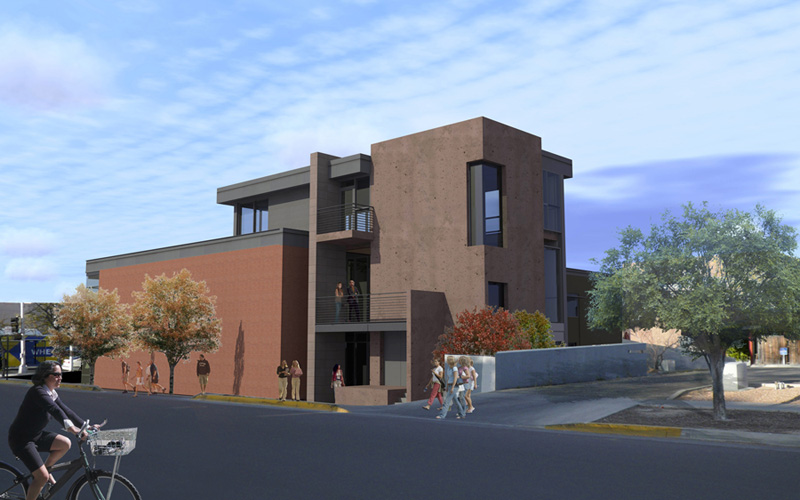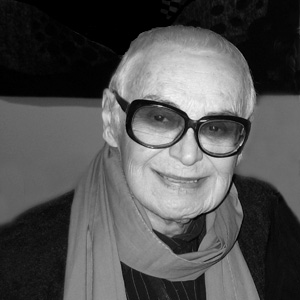
The Tamarind Institute
The Tamarind Institute Turns 50
June Wayne is nearly 93 years old, though were it not for an occasional quiver in her voice and movements, you might never guess it. In Albuquerque for the celebrations of Tamarind Institutes 50th anniversary, the elegant founder of the Institute — who remains its eloquent champion — wore her signature black glasses and communicated to a full house at Rodey Theater her sense of social consciousness, that led her to champion the vitality of lithography, gather a dynamic cadre of collaborators, and turn the practice of printmaking back into an international phenomenon.

June Wayne
How this all began — serendipitously — was a history that Wayne explained to a rapt crowd at University of New Mexicos Rodey Hall on September 11. Tamarind first “happened as a series of accidents,” she said.
Fifty years ago in Los Angeles (on Tamarind Avenue), Wayne assembled a coterie of like-minded printmakers and artists devoted to reviving American lithography ““ a discipline Wayne reminds was then facing extinction. With Clinton Adams and Garo Antreasian assisting her at the helm, Wayne and her troupe worked in cramped quarters with salvaged presses and materials trucked in from around the country (and out of basements where theyd otherwise have gone forgotten). The Tamarind Lithography Workshop, as it was known for the first 10 years, was supported almost entirely by the efforts of W. McNeil Lowry at the Ford Foundation ““ whose sponsorship of American arts Wayne reverently likened to the Florentine Medicis sponsorship of the Renaissance.
The Institutes initial impact was, Wayne describes, “one of instant revulsion around the country.” When she opened Tamarinds doors, the idea of real art produced under female supervision and outside the scope of the New York elite was generally dismissed. Yet early on, artists like Louise Nevelson and David Hockney collaborated with the workshops master printers. Through the legitimacy gained by such partnerships and the exceptional work produced, Tamarind had established itself as a West Coast cornerstone of the national art scene by the late 1960s. It was with this growing reputation that in 1970 the workshop moved to Albuquerque, formalized an affiliation with UNM and adopted its current moniker.

Jim Dine's "Double Dose"
In the years since, Tamarind Institutes master printers have partnered with the likes of Jim Dine (Double Dose, above) and Ed Ruscha, inspired the establishment of the now-foremost print supplier Takach Press and produced an alumni of talented printmakers many of whom are still in the forefront of contemporary art. The Institute is now largely self-sustainable, accruing about half of its annual operating expenses from the sale of original prints and the other half through a combination of grants, bequests, workshop and tuition fees.

Artist Ed Ruscha in front of "Burning Gas Station". Photo by Robert Bengston
Tamarinds anniversary festivities that culminated with the September 10-12 weekends round of celebrations and lectures and parties have actually spanned the course of this year, centered around the opening this spring of a spectacular new facility in the former UNM architecture building (renovation by Albuquerques DNCA Architect.) The festivities on Friday, September 10 opened with the presentation of Legacies in Lithography Awards to Wayne, Antreasian, Adams, Dine and Ruscha. Marjorie Devon ““ who joined the Tamarind staff in 1978 and has been Director since 1985 ““ led the ceremony, held in the new facilitys gallery, a light-filled second floor space that was hung with the works of the honorees. The weekend also marked the opening of Tamarind Touchstones: Fabulous at Fifty Celebrating Excellence in Fine Art Lithography, a retrospective at the UNM Art Museum, across the street from the Institute.
Saturdays events at Rodey Theatre started with a welcome from Devon, who shared a selection of photos from the archives and introduced Arif Khan, the current Gallery Director, to moderate a panel of Tamarind-trained printers presently working abroad. The participants ““ Mark Attwood (The Artists Press, South Africa), Plinio Avila Marquez (Museo Grabado, Mexico), Kalle Berg (Helsinki Litho, Finland ) and Sarah Dudley (Keystone Editions, Germany ) ““ shared their professional experiences, illustrating the innovation of Tamarinds printmakers across the world and demonstrating the palpable sense of solidarity they share.
In the afternoon, Ruth Fine, Curator for Special Projects at the National Gallery of Art, interviewed Jim Dine ““ who has executed (amid his painting career) over 1,000 prints, several with the Tamarind master printers. Art critic and MacArthur fellow Dave Hickey, who is a professor at UNM, then conversed with Ed Ruscha ( right)”“ whose longstanding relationship with lithography includes having seen prices for his prints reach the stratosphere (more than $170,000). And on Sunday morning, Garo Antreasian shared his encyclopedic knowledge of printmaking, submitting to a demonstration by Attwood that in the end proved the practice as much as the rhetoric is still as vital as when the founders named the Institute for the street they worked on in Los Angeles.
